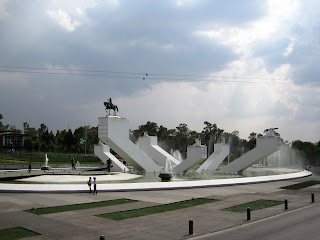From Mexico City we headed to the volcanoes national park of Popocatepetl and Iztaccihuatl, the second and third highest mountains in Mexico. Along the way we past farms and saw some old-style cultivation with the farmer guiding his plough which was being pulled by a horse. As we drove up the mountains and into clouds, it didn't bode well. As expected, both mountains were shrouded in clouds so we couldn't see very much :-( . The road through the park was interesting and at one point Mark did wonder whether or not we were on the right track. With enough ruts and potholes to shake your fillings loose, it put a massage chair to shame and we certainly felt invigorated by the time we got back onto tarmac.
We stopped for a few hours to visit the Great Pyramid of Cholula, also known a Tichihualtepetl, which is the largest pyramid (not tallest) known to exist in the world and dedicated to the god Quetzalcoatl.
So where is it? By the time the Spanish arrived, the pyramid was overgrown and the Catholic church had a practice of building on top of local religious sites. The Church of Our Lady of Remedies was built in 1594 and is a major pilgrimage destination. The site is also used for the celebration of indigenous rites. Due to the historic and religious significance of the church, the pyramid has not been excavated and restored although 8km (5m) of tunnels have been dug by archaeologists.
Next stop, Puebla City and in 1987 the historic centre was declared a World Heritage Site by UNESCO (yes I know, yet another one).This city is very important to Mexicans as a number of battles have started and ended here.
Evidence of the September 2017 earthquake could be seen everywhere, especially near our hotel with buildings being shored up and churches closed due to unstable walls, etc.
The next day we stopped at the town of Atlixco for brunch. The town is know for its production of ornamental plants and cut flowers. In the central square, murals had been made from different flowers in pots
(The Virgin Mary - side on)
More evidence of earthquake damage done to the cathedral
As it was too far to drive to the coast in one day, we had an overnight stop in Cuernavaca. During the Spanish conquest and then later in 1523, Cortes returned and founded the Church of San Jose and constructed the first sugar plantation. The Palace of Cortes was built in 1526 and is the oldest colonial era civil structure on the continental Americas (below)
Chapel of the third order of St Francis
The cathedral was built by Cortes to double as a fortress with cannons mounted above the buttresses
Having spent over 3 weeks above 2,000m it was great getting back to sea level and spending a week in Acapulco. I found an apartment only 40m from the beach and this is where we went every day
We went to see the cliff divers at La Quebrada. They've got some serious thrill issues. First they climb up the cliff (over 40m/135ft), which is quite impressive in itself, then they throw themselves off the top!
And now our relaxing week at the beach is done and its time to hit the road and carry on our voyage of discovery, this time heading to Oaxaca.

















































